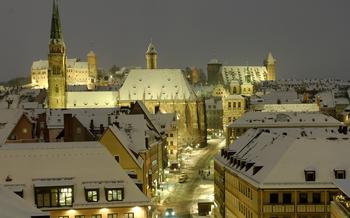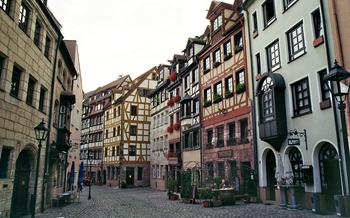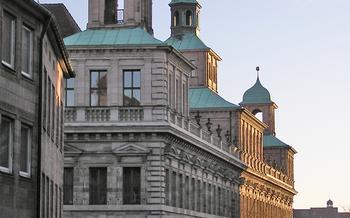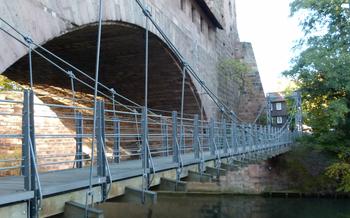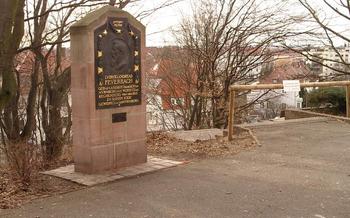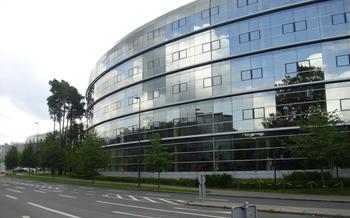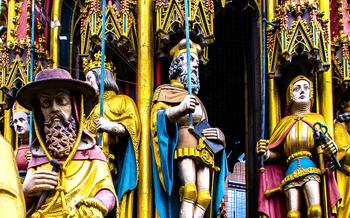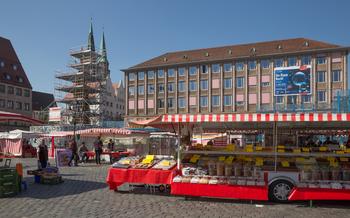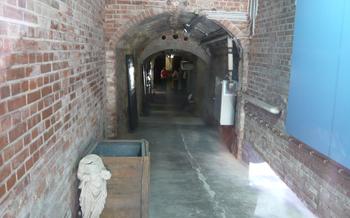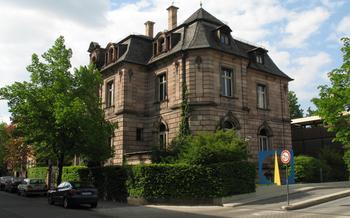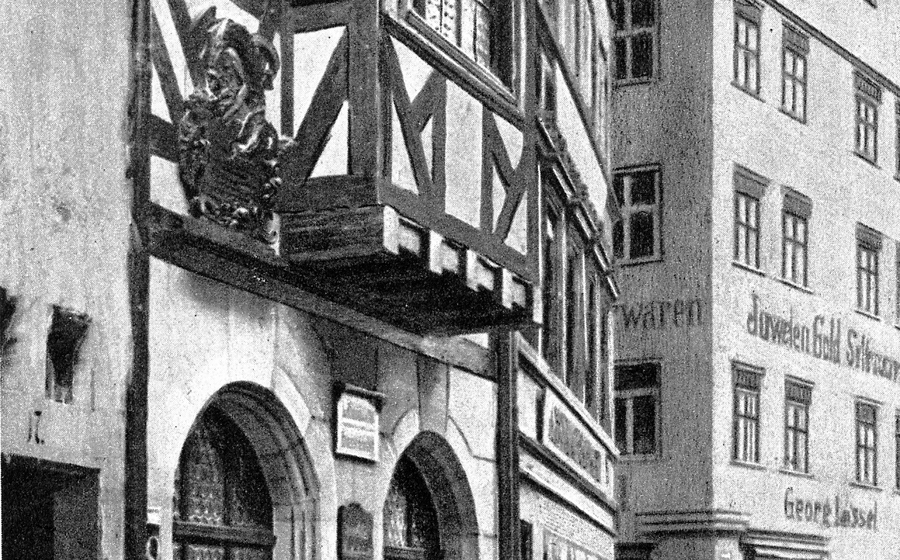
Hans Sachs House (Hans Sachs Haus)
- Hans Sachs House: A Cornerstone of Nuremberg's History
- Unveiling the Treasures of the Museum im Hans-Sachs-Haus
- A Tale of Two Houses: Exploring the Ensemble
- A Journey Through Time: The Zeittafel
- Unraveling the Secrets of the Courtyard
- A Haven for Art and Culture: The Gallery
- The Hans-Sachs-Brunnen: A Tribute to a Master Poet
- Delving into the Archives: The Handschriften- und Grafikabteilung
- Embracing the Spirit of Community: The Volksfeste
- A Literary Legacy: The Meistersinger Tradition
- A City Steeped in History: Exploring Nuremberg
- Practical Information for Visitors
- Capturing the Essence of Nuremberg: Photography Tips
- Insider Tip: Uncovering Local Delicacies
Hans Sachs House: A Cornerstone of Nuremberg's History
In the heart of Nuremberg, nestled amidst cobbled streets and medieval architecture, stands the Hans Sachs House (Hans Sachs Haus). This 16th-century building, steeped in historical significance, cultural importance, and architectural charm, serves as a testament to the city's rich past and its enduring legacy as a center of art, literature, and craftsmanship.
The Hans Sachs House, named after the renowned Meistersinger poet and playwright Hans Sachs, stands as a living tribute to his contributions to German literature and the cultural heritage of Nuremberg. With its distinctive facade, intricate carvings, and well-preserved interior, the house offers visitors a glimpse into the life and times of one of the city's most celebrated figures.
Beyond its historical significance, the Hans Sachs House holds a prominent place in Nuremberg's cultural landscape. It currently houses the Museum im Hans-Sachs-Haus, a treasure trove of local history and culture, showcasing permanent exhibitions, rotating displays, and interactive exhibits that captivate visitors of all ages.
Whether you're a history buff, an art enthusiast, or simply seeking to immerse yourself in the charm of Nuremberg, the Hans Sachs House beckons you to explore its many stories, revealing the essence of this captivating city.
Unveiling the Treasures of the Museum im Hans-Sachs-Haus
The Museum im Hans-Sachs-Haus is a treasure trove of local history, culture, and art, housed within the walls of the historic building. Visitors can delve into the rich tapestry of Nuremberg's past through permanent exhibitions and rotating displays that showcase diverse themes. Interactive exhibits engage visitors of all ages, while educational programs and workshops provide opportunities for deeper exploration and learning.
The permanent exhibitions focus on the life and works of Hans Sachs, the history of the Meistersinger tradition, and the cultural heritage of Nuremberg. Visitors can trace the footsteps of Hans Sachs, a renowned poet and Meistersinger, through personal artifacts, manuscripts, and interactive displays. The museum also delves into the cultural significance of the Meistersinger tradition, exploring its impact on German literature and music.
Rotating exhibitions offer a dynamic and diverse range of themes, showcasing local and international artists, historical events, and cultural phenomena. From contemporary art installations to historical artifacts, the museum presents a vibrant and ever-changing landscape of exhibitions that cater to a wide range of interests.
Interactive exhibits are designed to engage and educate visitors, particularly younger audiences. Hands-on activities, multimedia displays, and interactive games bring history and culture to life, fostering a deeper understanding and appreciation of Nuremberg's rich heritage. The museum's educational programs and workshops further enhance the learning experience, providing opportunities for students and enthusiasts to engage with experts, participate in hands-on activities, and explore specific themes in greater depth.
A Tale of Two Houses: Exploring the Ensemble
The original Hans Sachs House is a three-story timber-framed building with a distinctive facade. The ground floor features a shop and a workshop, while the upper floors were used as living quarters. The adjacent building, constructed in the 16th century, is a two-story stone structure with a Renaissance-style facade. It originally served as a storage facility and was later used as a school.
The two buildings were connected in the 18th century, creating a unified ensemble that is now known as the Hans Sachs House. The combined structure showcases a blend of architectural styles, from the Gothic elements of the original house to the Renaissance details of the adjacent building.
The connection between the two structures represents the evolution of Nuremberg's architecture and its changing needs over time. The ensemble serves as a reminder of the city's rich history and its ability to adapt and transform throughout the centuries.
A Journey Through Time: The Zeittafel
A unique feature of the Hans Sachs House is the Zeittafel, a remarkable timeline adorning the facade of the building. This intricate artwork serves as a visual representation of Nuremberg's rich history, stretching back to its origins in the 11th century. The Zeittafel is not merely a decorative element; it is a testament to the city's enduring spirit and the significant events that have shaped its identity.
Each panel of the Zeittafel depicts a different era or milestone in Nuremberg's past, from the founding of the city to its role as a center of trade and commerce, and its contributions to art and culture. Historical figures, architectural landmarks, and cultural achievements are meticulously portrayed, inviting viewers to embark on a journey through time. The Zeittafel is not just a timeline; it is a work of art that narrates the story of Nuremberg's evolution, resilience, and cultural heritage.
Beyond its historical significance, the Zeittafel holds symbolic meaning. It represents the interconnectedness of past, present, and future, reminding visitors of the enduring legacy of Nuremberg and its people. The Zeittafel is a testament to the power of collective memory and the importance of preserving and celebrating the city's rich cultural heritage.
Unraveling the Secrets of the Courtyard
The inner courtyard of the Hans Sachs House exudes an air of tranquility, inviting visitors to pause and reflect amidst the bustling city. Its cobblestone floor, surrounded by half-timbered buildings, evokes a sense of timelessness, transporting visitors back to the era of Hans Sachs. Architectural elements such as the intricate carvings on the wooden beams and the decorative window frames add to the charm of the courtyard, offering glimpses into the craftsmanship of the past.
In Hans Sachs' time, the courtyard played a vital role in daily life. It served as a communal space where residents gathered to socialize, exchange news, and celebrate special occasions. The courtyard also provided a practical function as a workshop, where Hans Sachs and his fellow shoemakers crafted their leather goods. Today, the courtyard continues to be a vibrant space, hosting events, exhibitions, and gatherings, allowing visitors to experience the cultural heritage of Nuremberg firsthand.
A Haven for Art and Culture: The Gallery
The Hans Sachs House is not just a museum but also a vibrant hub for art and culture. The gallery, located within the building, hosts rotating exhibitions showcasing local and international artists. Visitors can explore diverse mediums and artistic styles, ranging from paintings and sculptures to photography and installations. The gallery's mission is to promote artistic talent, encourage cultural exchange, and engage the local community.
Exhibitions change regularly, ensuring a fresh and dynamic experience for visitors. Local artists have the opportunity to showcase their works and gain recognition, while international artists bring new perspectives and influences to Nuremberg's cultural scene. The gallery also organizes events, workshops, and openings, creating a platform for artists to interact with the public and share their creative processes.
By supporting the gallery, visitors contribute to the vitality of Nuremberg's cultural landscape. They not only discover new artists and artworks but also become part of a vibrant community that values and celebrates creativity.
The Hans-Sachs-Brunnen: A Tribute to a Master Poet
In the heart of Nuremberg's historic city center, a captivating fountain stands as a testament to the enduring legacy of Hans Sachs. The Hans-Sachs-Brunnen graces the courtyard of the Hans Sachs House, paying homage to the beloved poet, playwright, and Meistersinger who left an indelible mark on German literature.
The fountain's design is a masterful blend of symbolism and artistry, honoring both Sachs' contributions and the rich cultural heritage of Nuremberg. At its center, the figure of Hans Sachs stands tall, his gaze directed towards the future, while his left hand rests gently on a book – a poignant symbol of his literary prowess. The fountain's basin is adorned with allegorical figures representing the arts and sciences, reflecting Sachs' diverse interests and the broader cultural landscape of his time.
Water cascades gently from the fountain's spout, creating a soothing melody that echoes throughout the courtyard. The sound of flowing water is a reminder of Sachs' ability to capture the essence of everyday life in his works, weaving together the joys and sorrows, the triumphs and tribulations of ordinary people.
The Hans-Sachs-Brunnen is not merely an ornamental feature; it is a profound tribute to a man who dedicated his life to enriching the cultural tapestry of Nuremberg. It serves as a reminder of the power of literature to inspire, uplift, and unite people across generations.
Delving into the Archives: The Handschriften- und Grafikabteilung
The Hans Sachs House is also home to the Handschriften- und Grafikabteilung, an extensive collection of manuscripts, prints, and drawings that offer a glimpse into Nuremberg's rich cultural heritage. This treasure trove of documents includes rare and valuable manuscripts dating back to the Middle Ages, as well as a vast collection of prints and drawings that showcase the artistic achievements of Nuremberg's past.
The Handschriften- und Grafikabteilung is a valuable resource for researchers and cultural enthusiasts alike. Scholars can access the archives to study rare manuscripts and documents that shed light on Nuremberg's history, art, and literature. The collection is also open to the public, allowing visitors to explore the fascinating world of Nuremberg's cultural heritage firsthand.
Whether you're a history buff, an art enthusiast, or simply curious about Nuremberg's past, the Handschriften- und Grafikabteilung is a must-visit destination. The collection's diverse holdings offer a unique opportunity to delve into the city's rich cultural tapestry and discover the stories that have shaped its identity.
Embracing the Spirit of Community: The Volksfeste
The courtyard of the Hans Sachs House transforms into a vibrant hub of activity during traditional festivals, known as Volksfeste. These celebrations are deeply rooted in local customs and traditions, offering visitors an immersive cultural experience. The Volksfeste showcase the spirit of community and camaraderie that has defined Nuremberg for centuries.
One of the most popular festivals is the Meistertrunk, which commemorates the granting of brewing rights to the city by Emperor Charles IV in 134During this festival, visitors can indulge in locally brewed beer and traditional Franconian cuisine while enjoying live music and performances.
Another highlight is the Altstadtfest, an annual event that celebrates Nuremberg's rich history and cultural heritage. The festival transforms the city center into a lively marketplace, with stalls selling handcrafted goods, local delicacies, and traditional costumes. Visitors can also enjoy historical reenactments, concerts, and street performances that bring the city's past to life.
By participating in these Volksfeste, visitors can immerse themselves in the vibrant community spirit of Nuremberg and experience the city's traditions and customs firsthand. These festivals offer a glimpse into the heart and soul of Nuremberg, making them a must-attend for anyone seeking an authentic cultural experience.
A Literary Legacy: The Meistersinger Tradition
Hans Sachs' legacy extends beyond his literary works. He played a pivotal role in the Meistersinger movement, a guild system of singing poets that flourished in Germany during the Middle Ages and Renaissance. The Meistersinger were skilled craftsmen who composed and performed songs based on traditional melodies and poetic forms. Sachs became a prominent member of the Nuremberg Meistersinger guild, serving as its "Merker" or judge, and helping to establish its rules and regulations.
Through his involvement in the Meistersinger tradition, Sachs contributed to the preservation and evolution of this unique form of musical and poetic expression. His songs, which often addressed social and moral issues, reflected the concerns and aspirations of the common people. Sachs' work helped to popularize the Meistersinger tradition and influenced the development of German literature and music.
In contemporary times, the Meistersinger tradition continues to be celebrated in Germany, with performances and competitions held throughout the country. Sachs' legacy as a master of the Meistersinger tradition is still revered, and his works continue to be studied and performed, ensuring the enduring significance of this unique cultural heritage.
A City Steeped in History: Exploring Nuremberg
Nuremberg, a city steeped in history and cultural heritage, offers a plethora of captivating landmarks and attractions that beckon travelers from across the globe. Beyond the allure of the Hans Sachs House, Nuremberg unveils a treasure trove of architectural wonders, historical sites, and cultural experiences.
Stroll along the picturesque streets of the Altstadt (Old Town), a UNESCO World Heritage Site, and marvel at the intricate facades of medieval buildings, each whispering tales of the city's rich past. Admire the grandeur of the Kaiserburg, an imposing castle that once served as the imperial residence of the Holy Roman Emperors.
Immerse yourself in the world of art at the Germanisches Nationalmuseum, home to an extensive collection of artifacts spanning from prehistoric times to the present day. Discover the masterpieces of Albrecht Dürer, Nuremberg's most celebrated artist, at the Albrecht Dürer House, where he lived and worked.
For a unique perspective of the city, embark on a leisurely boat trip along the Pegnitz River, meandering past historical bridges and picturesque landscapes. Nuremberg's charm extends beyond its iconic landmarks, inviting visitors to explore its vibrant culinary scene, bustling markets, and lively festivals. Savor the delectable taste of Nuremberg's famous sausages, indulge in traditional Franconian cuisine, and soak up the festive atmosphere of the Christkindlesmarkt, one of the oldest and most renowned Christmas markets in Germany.
Whether you're a history buff, an art enthusiast, or simply seeking an enchanting city break, Nuremberg promises an unforgettable journey through time, where every cobblestone tells a story and every moment holds the potential for discovery.
Practical Information for Visitors
Location and Accessibility: The Hans Sachs House is situated in the heart of Nuremberg's historic city center, at Hans-Sachs-Platz It is easily accessible by foot, bicycle, or public transportation. The nearest U-Bahn station is Lorenzkirche, a short walk from the house.
Opening Hours and Admission Fees: The Hans Sachs House is open to the public Tuesday to Sunday, from 10 am to 5 pm. Admission is free of charge, allowing visitors to explore the museum's exhibitions and the historic ensemble at their leisure.
Guided Tours and Educational Programs: Guided tours of the Hans Sachs House are available in German and English upon request. These tours provide deeper insights into the history, architecture, and cultural significance of the house and its collections. Educational programs and workshops are also offered for school groups and enthusiasts, focusing on local history, literature, and the Meistersinger tradition.
Facilities and Services: The Hans Sachs House offers a range of facilities and services for visitors. These include a gift shop where visitors can purchase souvenirs, books, and other items related to the house and its collections. Restrooms and a cloakroom are also available for the convenience of visitors.
Capturing the Essence of Nuremberg: Photography Tips
Architectural Masterpieces: - Explore the intricate details of the Hans Sachs House and other architectural wonders of Nuremberg. - Utilize a wide-angle lens to capture the grandeur of these structures against the city's backdrop.
Golden Hour Magic: - Plan your visit during the golden hours of sunrise and sunset for the most captivating light. - Experiment with different angles to capture the warm glow illuminating the city's landmarks.
Scenic River Views: - Take advantage of the picturesque views along the Pegnitz River. - Capture the reflection of bridges and buildings in the water for stunning compositions.
Street Life and Atmosphere: - Capture the essence of Nuremberg by photographing everyday scenes and street life. - Use a fast shutter speed to freeze the movement and convey the city's vibrant energy.
Nuremberg from Above: - Climb to the top of the Nuremberg Castle or other vantage points for breathtaking cityscapes. - Experiment with different focal lengths to capture both wide-angle city views and close-up details.
Storytelling Through Images: - Look for unique perspectives and stories to tell through your photographs. - Engage with locals and capture their interactions with the city's landmarks.
Insider Tip: Uncovering Local Delicacies
Nuremberg is a culinary paradise, offering a tantalizing array of traditional dishes and local specialties that will delight your taste buds. Indulge in the iconic Nuremberg sausages, grilled to perfection and served with sauerkraut and mashed potatoes. Sample the delicious Lebkuchen, a gingerbread-like cookie with a centuries-old history, and savor the unique taste of Schäufele, a roasted pork shoulder that melts in your mouth.
To experience the true essence of Nuremberg's culinary scene, visit the lively food markets, such as the Hauptmarkt and the Lorenzer Markt. Here, you can browse stalls laden with fresh produce, artisanal cheeses, and homemade delicacies. Don't miss the opportunity to try the local specialty, Zwetschgenmännle, a sweet pastry filled with plums, a symbol of the city's rich culinary heritage.
For a memorable dining experience, venture into the heart of Nuremberg's Old Town, where you'll find a plethora of traditional restaurants and cozy taverns. Sample the flavorful Schäufele at the renowned Bratwurst Röslein, or indulge in a hearty plate of Nürnberger Rostbratwürste at the Albrecht Dürer Stube.
Nuremberg's culinary delights are sure to leave an unforgettable impression on your palate. Embrace the opportunity to savor the city's rich gastronomic heritage, from its iconic sausages to its delectable pastries and traditional dishes.
